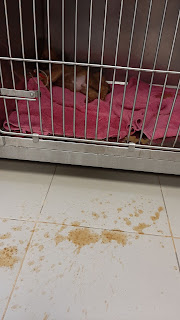PARVOVIRUS
PARVOVIRUS
The virus has been present for the ages already.
Just imagine my dad, also a veterinarian has diagnosed this infection before during his small animal practitioner days. If I can recall they do not have those 10-minute lateral flow test kits available that time, and they are able to diagnosed the condition based on their clinical eye. My big brother has also seen this virus during his clinical duties as well. That is how long this viral infection has tormented pets and I believe as veterinarian, we just got to be ready to identify this infection from the vast causes of vomiting/diarrhea symptoms.
One of the important components of our 5in1 or DHLLP vaccination for dogs.
A hardy virus that can resist disinfection. Known route of transmission thru our pets is thru feco-oral. The infection starts when our puppy accidentally ingest virus laden fecal material. We can also transmit the disease thru our shoes when we stepped on infected material, and then bring our shoes inside homes (fomite transmission). Flies can serve as vectors as well. That shows how easy to spread this viral infection.
Clinical sign commonly observed: protracted vomiting and bloody diarrhea - pets vomit and have watery diarrhea even without even having food and water😪
When a puppy is presented at the clinic with the aforementioned symptoms, Parvovirus has to be ruled out first. When this two clinical signs are together, CPV is always part of the differential diagnosis list that every clinician would want to rule out ASAP. The presence of the unique metallic odor observed on the stool can help differentiate the disease from conditions like from adverse food reactions.
In reality also we encounter pups that are infected that have no symptoms at all, and this can be challenging to the veterinarian and frustrating to the owners.
WORST CASE: Sudden death of the affected animal can happen
This is the sad reality for new pet parents. This virus has high mortality rate.
Young pups and Unvaccinated dogs that have exposure to the environment are susceptible to the infection.
Puppies that are unvaccinated and less than 6 months. Mortality is higher on this age group for pups. I have seen personally dogs that are 1 year and 5 months having parvovirus infection. Let us say that this also depends on the exposure of the animal. Adults are not 100 percent spared from the infection but their bodies are usually ready to fight the infection.
CPV-2 is a close relative of Feline Panleucopenia Virus
Multi-pup households with poor vaccination programs increases the chance of having an outbreak.
DIAGNOSIS
Your veterinarian's experience.
Base on the quality of the stool and by accidentally "sniffing" the odor of the stool during temperature check, your veterinarian can likely tell parvo infection.
Advancement of test kits have made identification of sick animals easier than before. ELISA test kits are available and it can easily determine a positive sick animal. Testing for the disease is essential to differentiate other gastro-intestinal infection like Giardiasis in puppies.
Your veterinarian will correlate test results with the clinical signs exhibited by your puppy to establish diagnosis of the disease.
WHAT CAN WE DO ONCE DIAGNOSED OF THE INFECTION:
defintely we can do something...
Symptomatic and Supportive treatment.
INTRAVENOUS FLUID THERAPY is the cornerstone of treatment.
This includes aggressive IV fluid therapy, anti-bacterials to prevent secondary infections. Anti-emetics to control vomiting. Nutritional support to avoid further deterioration of the puppy. Back home in the Philippines, Immunoglobulins are also given to the sick animals to hasten recovery. Strict isolation of sick animals is highly recommended to prevent spread of a stable virus.
PREVENTION IS BETTER THAN CURE
Vaccination is still the way to go!
Kindly check the blog entitled DOG HEALTH PROGRAM. You will be able to see the age and the vaccination recommended for your puppies. Best to see your veterinarian
Source:
Blackwell Five Minute Veterinary Consult Clinical: Canine and Feline. 6th edition.
Wiley-Blackwell
Alex Gallagher, DVM (June 2020) Merck Veterinary Manual.
https://www.merckvetmanual.com/digestive-system/diseases-of-the-stomach-and-intestines-in-small-animals/canine-parvovirus. Accessed 28 July 2020.






Comments
Post a Comment